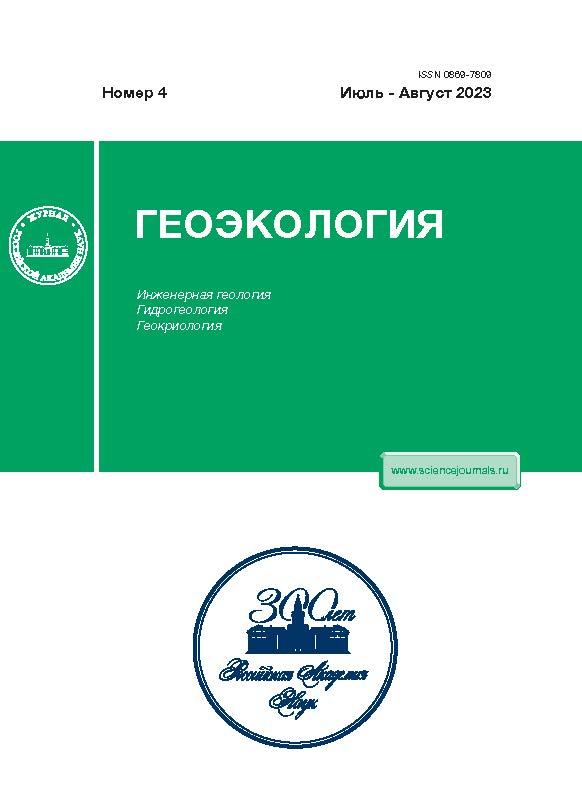DEWATERING AS A LEADING FACTOR IN THE DEVELOPMENT OF SUFFUSION UPON THE CONSTRUCTION OF DEEP FOUNDATIONS
- Authors: Kashperyuk P.I.1, Moskalev D.S.1, Khomenko V.P.1
-
Affiliations:
- Moscow State Civil Engineering University
- Issue: No 4 (2023)
- Pages: 18-28
- Section: ФУНКЦИОНИРОВАНИЕ ПРИРОДНЫХ И ПРИРОДНО-ТЕХНИЧЕСКИХ СИСТЕМ
- URL: https://journals.eco-vector.com/0869-7809/article/view/660582
- DOI: https://doi.org/10.31857/S0869780923030049
- EDN: https://elibrary.ru/WMOLHF
- ID: 660582
Cite item
Full Text
Abstract
The article considers the main technogenic factors leading to the development of mechanical suffusion during the construction and operation of buildings and structures with deep foundations. At a specific object, the dynamics of the development of an ascending suffusion process of a “volcanic” nature (“pseudovolcanic suffusion”) caused by systematic water drawdown and discontinuity of the upper aquiclude during construction work was studied. It is proved that the need for constant pumping groundwater entering the drainage system results rather from the violation of the upper aquiclude continuity, serving the soil foundation upon the construction of “retaining wall” and pile foundation than from the engineering defects in the constructed impervious screen. The research results made it possible for the first time to evaluate the possibilities of using two methods for determining the development of the ascending suffusion process in time; the method of measuring the duty cycles with a caliper and the method of filling the duty cycles with medium-sized sand until the formed volume is completely filled. Based on the laws of hydrodynamics, an attempt was made to determine the speed of the upward flow and the magnitude of the hydrophysical head. It is noted that the most important condition for the production of engineering surveys, when identifying interstratal high-pressure aquifers in the soils of the base, should be the mandatory plugging of exploration wells with high-quality concrete mortar in the range of depths of the bottom of the upper aquiclude and, at least, the design mark of the bottom of the pit, immediately after the completion of drilling.
About the authors
P. I. Kashperyuk
Moscow State Civil Engineering University
Author for correspondence.
Email: npf-sivs@yandex.ru
Russia, 129337, Moscow,
Yaroslavskoe shosse, 26
D. S. Moskalev
Moscow State Civil Engineering University
Author for correspondence.
Email: cangaro@mail.ru
Russia, 129337, Moscow,
Yaroslavskoe shosse, 26
V. P. Khomenko
Moscow State Civil Engineering University
Author for correspondence.
Email: khomenko_geol@mail.ru
Russia, 129337, Moscow,
Yaroslavskoe shosse, 26
References
- Anikeev, A.A. Metodika otsenki karstovo-suffozionnoi opasnosti i riska v Moskve [Methodology for assessing karst-suffusion hazard and risk in Moscow]. Moscow, Lambert Academic Publishing, 2017, 80 p. (in Russian)
- Anisimov, V.V., Ter-Martirosyan, Z.G. Vliyanie mekhanicheskoi suffozii na dopolnitel’nye osadki osnovanii fundamentov [Influence of mechanical suffusion on additional settlements of foundation foundations]. Osnovaniya, fundamenty i mekhanika gruntov, 2009, no. 4, p. 4–8. (in Russian)
- Inzhenernaya geologiya Rossii. T.2. Inzhenernaya geodinamika territorii Rossii [Engineering geology of Russia. Vol. 2. Engineering geodynamics of the territory of Russia]. V.T. Trofimov, E.V. Kalinin, Eds. Moscow, “KDU” Publ. house. 2013, 816 p. (in Russian)
- Kashperyuk, P.I., Lavrusevich, A.A., Nikitina, K.V., Krasheninnikov, V.S. Proektnye resheniya v sovremennom fundamentostroenii: funktsiya prognoza raboty sistemy “osnovanie-fundament” [Design solutions in modern foundation engineering – the function of forecasting the “soil-foundation” system operation]. Promyshlennoe i grazhdanskoe stroitel’stvo, 2018, no. 12, pp. 49–54. (in Russian)
- Kashperyuk, P.I., Nikitina, K.V. K voprosy o karstovo-suffozionnykh proyavleniyakh v karstuyushchikhsya tolshchakh g. Moskvy [About karst-suffosion manifestations in the karstified strata of Moscow]. In: Opasnye dlya stroitelstva geologicheskie protsessy. Mater. mezhd. seminara, posv. 70-letiyu prof. V.P. Khomenko [Hazardous for construction geological processes: Proc. Intern. Workshop devoted to 70th anniversary of Prof. V.P. Khomenko]. 2019, pp. 40–42. (in Russian)
- Kochev, A.D., Chertkov, L.G., Zayonts, I.L. K voprosy geologicheskogo raionirovaniya territorii severo-zapada Moskvy po stepeni opasnosti razvitiya karstovo-suffozionnykh protsessov [About geological zoning of the territory in the north-west of Moscow according to the hazard of karst-suffosion development]. Proc. Sci.-Pract. Conference “Present-day engineering-geological problems and methods of their solution”. Moscow, Geomarketing Publ., 2017, pp. 24–40. (in Russian)
- Lavrusevich, I.A., Khomenko, V.P., Lavrusevich, A.A. Nedootsenka suffozionnoi opasnosti pri stroitel’stve ploskostnykh betonnykh sooruzhenii [Underestimating the suffusion hazard upon constructing planar concrete structures]. Promyshlennoe i grazhdanskoe stroitel’stvo, 2015, no. 11, pp. 21–24. (in Russian)
- Opasnye ekzogennye protsessy [Hazardous exogenous processes]. V.I. Osipov, V.M. Kutepov, V.P. Zverev, et al. Moscow, GEOS Publ., 1999, 271 p. (in Russian)
- Khomenko, V.P. Zakonomernosti i prognoz suffozionnykh protsessov [Patterns and forecast of suffusion processes]. Moscow, GEOS Publ., 2003, 216 p. (in Russian)
- Khomenko, V.P. Karstovoe provaloobrazovanie: mekhanizm i otsenka opasnosti [Karst sinkhole formation: mechanism and risk assessment]. Proc. Intern. Symposium “Environmental safety and construction in karst areas”. Kataev V.N. et al., Eds., Perm, PGU Publ., 2015, p. 50–60. (in Russian)
- Shcherbakov, S.V. Prognozirovanie ustoichivosti sooruzhenii v zavisimosti ot suffozionnosti gruntov [Forecasting the stability of structures depending on soil suffusion]. Trofimuk Readings, Novosibirsk, Institute of Petroleum Geology and Geophysics SO RAN, 2013, pp. 584–586. (in Russian)
- Erosion of geomaterials. S. Bonelli, Ed., New York, ISTE/Wiley Publ., 2012, 371 p.
- Kälin, M. Hydraulic piping – theoretical and experimental findings. Canadian Geotechnical Journal, 1977, vol. 14, no 1, pp. 107–124.
Supplementary files

















